Thiophene- and Carbazole-Substituted N-Methyl-Fulleropyrrolidine Acceptors in PffBT4T-2OD Based Solar Cells
Abstract
1. Introduction
2. Materials and Methods
2.1. Materials
2.2. NMR Spectroscopy
2.3. Preparation of Compounds 60A–60D and 70A–70D
2.4. Cyclic Voltammetry
2.5. Ab Initio DFT Calculations
2.6. Absorption Spectroscopy
2.7. Device Fabrication
2.8. Device Performance Characterization
2.9. Atomic Force Microscopy (AFM)
3. Results and Discussion
4. Conclusions
Supplementary Materials
Author Contributions
Funding
Acknowledgments
Conflicts of Interest
References
- Inganas, O. Organic Photovoltaics over Three Decades. Adv. Mater. 2018, 30. [Google Scholar] [CrossRef] [PubMed]
- Yu, J.S.; Zheng, Y.F.; Huang, J. Towards High Performance Organic Photovoltaic Cells: A Review of Recent Development in Organic Photovoltaics. Polymers 2014, 6, 2473–2509. [Google Scholar] [CrossRef]
- Sondergaard, R.; Hosel, M.; Angmo, D.; Larsen-Olsen, T.T.; Krebs, F.C. Roll-to-roll fabrication of polymer solar cells. Mater. Today 2012, 15, 36–49. [Google Scholar] [CrossRef]
- Xiao, Z.; Jia, X.; Ding, L.M. Ternary organic solar cells offer 14% power conversion efficiency. Sci. Bull. 2017, 62, 1562–1564. [Google Scholar] [CrossRef]
- Li, S.S.; Ye, L.; Zhao, W.C.; Yan, H.P.; Yang, B.; Liu, D.L.; Li, W.N.; Ade, H.; Hou, J.H. A Wide Band Gap Polymer with a Deep Highest Occupied Molecular Orbital Level Enables 14.2% Efficiency in Polymer Solar Cells. J. Am. Chem. Soc. 2018, 140, 7159–7167. [Google Scholar] [CrossRef] [PubMed]
- Cui, Y.; Yao, H.F.; Zhang, J.Q.; Zhang, T.; Wang, Y.M.; Hong, L.; Xian, K.H.; Xu, B.W.; Zhang, S.Q.; Peng, J.; et al. Over 16% efficiency organic photovoltaic cells enabled by a chlorinated acceptor with increased open-circuit voltages. Nat. Commun. 2019, 10, 8. [Google Scholar] [CrossRef]
- Meng, L.X.; Zhang, Y.M.; Wan, X.J.; Li, C.X.; Zhang, X.; Wang, Y.B.; Ke, X.; Xiao, Z.; Ding, L.M.; Xia, R.X.; et al. Organic and solution-processed tandem solar cells with 17.3% efficiency. Science 2018, 361, 1094. [Google Scholar] [CrossRef]
- Zhang, S.Q.; Ye, L.; Zhao, W.C.; Liu, D.L.; Yao, H.F.; Hou, J.H. Side Chain Selection for Designing Highly Efficient Photovoltaic Polymers with 2D-Conjugated Structure. Macromolecules 2014, 47, 4653–4659. [Google Scholar] [CrossRef]
- Ma, W.; Yang, G.F.; Jiang, K.; Carpenter, J.H.; Wu, Y.; Meng, X.Y.; McAfee, T.; Zhao, J.B.; Zhu, C.H.; Wang, C.; et al. Influence of Processing Parameters and Molecular Weight on the Morphology and Properties of High-Performance PffBT4T-2OD:PC71BM Organic Solar Cells. Adv. Energy Mater. 2015, 5, 9. [Google Scholar] [CrossRef]
- Liu, Y.; Zhao, J.; Li, Z.; Mu, C.; Ma, W.; Hu, H.; Jiang, K.; Lin, H.; Ade, H.; Yan, H. Aggregation and morphology control enables multiple cases of high-efficiency polymer solar cells. Nat. Commun. 2014, 5, 5293. [Google Scholar] [CrossRef]
- Zhang, Y.; Parnell, A.J.; Pontecchiani, F.; Cooper, J.F.K.; Thompson, R.L.; Jones, R.A.L.; King, S.M.; Lidzey, D.G.; Bernardo, G. Understanding and controlling morphology evolution via DIO plasticization in PffBT4T-2OD/PC71BM devices. Sci. Rep. 2017, 7, 44269. [Google Scholar] [CrossRef]
- Zhang, Y.W.; Parnell, A.J.; Blaszczyk, O.; Musser, A.J.; Samuel, I.D.W.; Lidzey, D.G.; Bernardo, G. Effect of fullerene acceptor on the performance of solar cells based on PffBT4T-2OD. Phys. Chem. Chem. Phys. 2018, 20, 19023–19029. [Google Scholar] [CrossRef]
- Zhang, W.; Hu, R.; Zeng, X.K.; Su, X.J.; Chen, Z.F.; Zou, X.S.; Peng, J.; Zhang, C.Y.; Yartsev, A. Effect of Post-Thermal Annealing on the Performance and Charge Photogeneration Dynamics of PffBT4T-2OD/PC71BM Solar Cells. Polymers 2019, 11, 408. [Google Scholar] [CrossRef]
- Bi, Z.Z.; Naveed, H.B.; Mao, Y.M.; Yan, H.P.; Ma, W. Importance of Nucleation during Morphology Evolution of the Blade-Cast PffBT4T-2OD-Based Organic Solar Cells. Macromolecules 2018, 51, 6682–6691. [Google Scholar] [CrossRef]
- Duan, L.P.; Yi, H.M.; Wang, Z.M.; Zhang, Y.; Haque, A.A.Z.; Sang, B.R.; Deng, R.; Uddin, A. Semitransparent organic solar cells based on PffBT4T-2OD with a thick active layer and near neutral colour perception for window applications. Sustain. Energy Fuels 2019, 3, 2456–2463. [Google Scholar] [CrossRef]
- Ganesamoorthy, R.; Sathiyan, G.; Sakthivel, P. Review: Fullerene based acceptors for efficient bulk heterojunction organic solar cell applications. Sol. Energy Mater. Sol. Cells 2017, 161, 102–148. [Google Scholar] [CrossRef]
- Gaspar, H.; Figueira, F.; Pereira, L.; Mendes, A.; Viana, C.J.; Bernardo, G. Recent Developments in the Optimization of the Bulk Heterojunction Morphology of Polymer: Fullerene Solar Cells. Materials 2018, 11, 2560. [Google Scholar] [CrossRef]
- Zhang, C.H.; Mumyatov, A.; Langner, S.; Perea, J.D.; Kassar, T.; Min, J.; Ke, L.L.; Chen, H.W.; Gerasimov, K.L.; Anokhin, D.V.; et al. Overcoming the Thermal Instability of Efficient Polymer Solar Cells by Employing Novel Fullerene-Based Acceptors. Adv. Energy Mater. 2017, 7. [Google Scholar] [CrossRef]
- Zhang, C.; Langner, S.; Mumyatov, A.V.; Anokhin, D.V.; Min, J.; Perea, J.D.; Gerasimov, K.L.; Osvet, A.; Ivanov, D.A.; Troshin, P.; et al. Understanding the correlation and balance between the miscibility and optoelectronic properties of polymer–fullerene solar cells. J. Mater. Chem. A 2017, 5, 17570–17579. [Google Scholar] [CrossRef]
- Srivani, D.; Gupta, A.; Bhosale, S.V.; Ohkubo, K.; Bhosale, R.S.; Fukuzumi, S.; Bilic, A.; Jones, L.A.; Bhosale, S.V. A Triphenylamine-Naphthalenediimide-Fullerene Triad: Synthesis, Photoinduced Charge Separation and Solution-Processable Bulk Heterojunction Solar Cells. Asian J. Org. Chem. 2018, 7, 220–226. [Google Scholar] [CrossRef]
- Landerer, D.; Sprau, C.; Baumann, D.; Pingel, P.; Leonhard, T.; Zimmermann, D.; Chochos, C.L.; Kruger, H.; Janietz, S.; Colsmann, A. Thermal Stabilization of the Bulk-Heterojunction Morphology in Polymer:Fullerene Solar Cells Using a Bisazide Cross-Linker. Solar Rrl 2019, 3. [Google Scholar] [CrossRef]
- Wang, W.; Sun, R.; Guo, J.; Guo, J.; Min, J. An Oligothiophene-Fullerene Molecule with a Balanced Donor-Acceptor Backbone for High-Performance Single-Component Organic Solar Cells. Angew. Chem. Int. Ed. 2019, 58, 14556–14561. [Google Scholar] [CrossRef]
- Sariciftci, N.S.; Smilowitz, L.; Heeger, A.J.; Wudl, F. Photoinduced electron-transfer from a conducting polymer to Buckminsterfullerene. Science 1992, 258, 1474–1476. [Google Scholar] [CrossRef]
- Hummelen, J.C.; Knight, B.W.; Lepeq, F.; Wudl, F.; Yao, J.; Wilkins, C.L. Preparation and characterization of fulleroid and methanofullerene derivatives. J. Org. Chem. 1995, 60, 532–538. [Google Scholar] [CrossRef]
- Yu, G.; Gao, J.; Hummelen, J.C.; Wudl, F.; Heeger, A.J. Polymer photovoltaic cells - Enhanced efficiencies via a network of internal donor-acceptor heterojunctions. Science 1995, 270, 1789–1791. [Google Scholar] [CrossRef]
- Wienk, M.M.; Kroon, J.M.; Verhees, W.J.H.; Knol, J.; Hummelen, J.C.; van Hal, P.A.; Janssen, R.A.J. Efficient methano 70 fullerene/MDMO-PPV bulk heterojunction photovoltaic cells. Angew. Chem. Int. Ed. 2003, 42, 3371–3375. [Google Scholar] [CrossRef]
- Williams, M.; Tummala, N.R.; Aziz, S.G.; Risko, C.; Bredas, J.L. Influence of Molecular Shape on Solid-State Packing in Disordered PC61BM and PC71BM Fullerenes. J. Phys. Chem. Lett. 2014, 5, 3427–3433. [Google Scholar] [CrossRef]
- Zhang, F.J.; Zhuo, Z.L.; Zhang, J.; Wang, X.; Xu, X.W.; Wang, Z.X.; Xin, Y.S.; Wang, J.; Tang, W.H.; Xu, Z.; et al. Influence of PC60BM or PC70BM as electron acceptor on the performance of polymer solar cells. Sol. Energy Mater. Sol. Cells 2012, 97, 71–77. [Google Scholar] [CrossRef]
- Saianand, G.; Gopalan, A.-I.; Lee, J.-C.; Sathish, C.; Gopalakrishnan, K.; Unni, G.E.; Shanbhag, D.; Dasireddy, V.D.B.C.; Yi, J.; Xi, S.; et al. Mixed Copper/Copper-Oxide Anchored Mesoporous Fullerene Nanohybrids as Superior Electrocatalysts toward Oxygen Reduction Reaction. Small 2020, 16, 1903937. [Google Scholar] [CrossRef]
- Bairi, P.; Tsuruoka, T.; Acharya, S.; Ji, Q.; Hill, J.P.; Ariga, K.; Yamauchi, Y.; Shrestha, L.K. Mesoporous fullerene C70 cubes with highly crystalline frameworks and unusually enhanced photoluminescence properties. Mater. Horiz. 2018, 5, 285–290. [Google Scholar] [CrossRef]
- Benzigar, M.R.; Joseph, S.; Saianand, G.; Gopalan, A.-I.; Sarkar, S.; Srinivasan, S.; Park, D.-H.; Kim, S.; Talapaneni, S.N.; Ramadass, K.; et al. Highly ordered iron oxide-mesoporous fullerene nanocomposites for oxygen reduction reaction and supercapacitor applications. Microporous Mesoporous Mater. 2019, 285, 21–31. [Google Scholar] [CrossRef]
- Li, C.-Z.; Yip, H.-L.; Jen, A.K.Y. Functional fullerenes for organic photovoltaics. J. Mater. Chem. 2012, 22, 4161–4177. [Google Scholar] [CrossRef]
- Mi, D.; Kim, J.H.; Kim, H.U.; Xu, F.; Hwang, D.H. Fullerene Derivatives as Electron Acceptors for Organic Photovoltaic Cells. J. Nanosci. Nanotechnol. 2014, 14, 1064–1084. [Google Scholar] [CrossRef]
- Kitaura, S.; Kurotobi, K.; Sato, M.; Takano, Y.; Umeyama, T.; Imahori, H. Effects of dihydronaphthyl-based 60 fullerene bisadduct regioisomers on polymer solar cell performance. Chem. Commun. 2012, 48, 8550–8552. [Google Scholar] [CrossRef]
- He, Y.; Chen, H.-Y.; Hou, J.; Li, Y. Indene−C60 Bisadduct: A New Acceptor for High-Performance Polymer Solar Cells. J. Am. Chem. Soc. 2010, 132, 1377–1382. [Google Scholar] [CrossRef]
- Deng, L.L.; Feng, J.; Sun, L.C.; Wang, S.; Xie, S.L.; Xie, S.Y.; Huang, R.B.; Zheng, L.S. Functionalized dihydronaphthyl-C-60 derivatives as acceptors for efficient polymer solar cells with tunable photovoltaic properties. Sol. Energy Mater. Sol. Cells 2012, 104, 113–120. [Google Scholar] [CrossRef]
- Meng, X.Y.; Zhang, W.Q.; Tan, Z.A.; Du, C.; Li, C.H.; Bo, Z.S.; Li, Y.F.; Yang, X.L.; Zhen, M.M.; Jiang, F.; et al. Dihydronaphthyl-based 60 fullerene bisadducts for efficient and stable polymer solar cells. Chem. Commun. 2012, 48, 425–427. [Google Scholar] [CrossRef]
- Lee, J.K.; Fujida, K.; Tsutsui, T.; Kim, M.R. Synthesis and photovoltaic properties of soluble fulleropyrrolidine derivatives for organic solar cells. Sol. Energy Mater. Sol. Cells 2007, 91, 892–896. [Google Scholar] [CrossRef]
- Matsumoto, K.; Hashimoto, K.; Kamo, M.; Uetani, Y.; Hayase, S.; Kawatsura, M.; Itoh, T. Design of fulleropyrrolidine derivatives as an acceptor molecule in a thin layer organic solar cell. J. Mater. Chem. 2010, 20, 9226–9230. [Google Scholar] [CrossRef][Green Version]
- Mi, D.; Kim, H.U.; Kim, J.H.; Xu, F.; Jin, S.H.; Hwang, D.H. Synthesis of a soluble fulleropyrrolidine derivative for use as an electron acceptor in bulk-heterojunction polymer solar cells. Synth. Met. 2012, 162, 483–489. [Google Scholar] [CrossRef]
- Saravanan, C.; Liu, C.-L.; Chang, Y.-M.; Lu, J.-D.; Hsieh, Y.-J.; Rwei, S.-P.; Wang, L. [60]Fulleropyrrolidines Bearing π-Conjugated Moiety for Polymer Solar Cells: Contribution of the Chromophoric Substituent on C60 to the Photocurrent. ACS Appl. Mater. 2012, 4, 6133–6141. [Google Scholar] [CrossRef]
- Zhang, X.N.; Sun, L.; Zheng, W.; Bao, X.C.; Wang, N.; Wang, T.; Yang, R.Q. The preparation and properties of bulk-heterojunction organic solar cells with indole-containing fulleropyrrolidine derivatives as acceptors. Tetrahedron 2013, 69, 9544–9550. [Google Scholar] [CrossRef]
- Karakawa, M.; Nagai, T.; Adachi, K.; Ie, Y.; Aso, Y. N-phenyl 60 fulleropyrrolidines: Alternative acceptor materials to PC61BM for high performance organic photovoltaic cells. J. Mater. Chem. A 2014, 2, 20889–20895. [Google Scholar] [CrossRef]
- Kaunisto, K.M.; Subbaiyan, N.K.; Bikram, K.C.C.; Chukharev, V.I.; Hakola, H.M.; Vuorinen, T.K.; Manninen, V.M.; Tkachenko, N.V.; Lemmetyinen, H.J.; D’Souza, F. The effect of thiophene substituents of fulleropyrrolidine acceptors on the performance of inverted organic solar cells. Synth. Met. 2014, 195, 193–200. [Google Scholar] [CrossRef]
- Pitliya, P.; Sun, Y.; Garza, J.C.; Liu, C.; Gong, X.; Karim, A.; Raghavan, D. Synthesis and characterization of novel fulleropyrrolidine in P3HT blended bulk heterojunction solar cells. Polymer 2014, 55, 1769–1781. [Google Scholar] [CrossRef]
- Liang, Y.L.; Hao, Y.J.; Liu, X.D.; Feng, L.; Chen, M.Z.; Tang, Q.Q.; Chen, N.; Tang, M.L.; Sun, B.B.; Zhou, Y.; et al. Efficiency enhancement from 60 fulleropyrrolidine-based polymer solar cells through N-substitution manipulation. Carbon 2015, 92, 185–192. [Google Scholar] [CrossRef]
- Yamane, S.; Mizukado, J.; Takahashi, T.; Suzuki, Y.; Sakurai, M.; Hagihara, H.; Suda, H. Fulleropyrrolidine Derivatives with Benzophenone Moiety as Electron Acceptors in Thermally Stable Organic Photovoltaic Devices. Chem. Lett. 2015, 44, 527–529. [Google Scholar] [CrossRef]
- Prato, M.; Maggini, M.; Giacometti, C.; Scorrano, G.; Sandona, G.; Farnia, G. Synthesis and electrochemical properties of substituted fulleropyrrolidines. Tetrahedron 1996, 52, 5221–5234. [Google Scholar] [CrossRef]
- Grimme, S.; Brandenburg, J.G.; Bannwarth, C.; Hansen, A. Consistent structures and interactions by density functional theory with small atomic orbital basis sets. J. Chem. Phys. 2015, 143, 054107. [Google Scholar] [CrossRef]
- Karton, A.; Waite, S.L.; Page, A.J. Performance of DFT for C60 Isomerization Energies: A Noticeable Exception to Jacob’s Ladder. J. Phys. Chem. A 2019, 123, 257–266. [Google Scholar] [CrossRef]
- Wang, H.; He, Y.; Li, Y.; Su, H. Photophysical and Electronic Properties of Five PCBM-like C60 Derivatives: Spectral and Quantum Chemical View. J. Phys. Chem. A 2012, 116, 255–262. [Google Scholar] [CrossRef]
- Beu, T.A.; Onoe, J.; Hida, A. First-principles calculations of the electronic structure of one-dimensional C-60 polymers. Phys. Rev. B 2005, 72, 155416. [Google Scholar] [CrossRef]
- Neese, F. The ORCA program system. Wiley Interdiscip. Rev. Comput. Mol. Sci. 2012, 2, 73–78. [Google Scholar] [CrossRef]
- Bernardo, G.; Melle-Franco, M.; Washington, A.L.; Dalgliesh, R.M.; Li, F.; Mendes, A.; Parnell, S.R. Different agglomeration properties of PC61BM and PC71BM in photovoltaic inks—A spin-echo SANS study. Rsc Adv. 2020, 10, 4512–4520. [Google Scholar] [CrossRef]
- Gaspar, H.; Figueira, F.; Strutyński, K.; Melle-Franco, M.; Ivanou, D.; Tomé, J.P.C.; Pereira, C.M.; Pereira, L.; Mendes, A.; Viana, J.C.; et al. PffBT4T-2OD Based Solar Cells with Aryl-Substituted N-Methyl-Fulleropyrrolidine Acceptors. Materials 2019, 12, 4100. [Google Scholar] [CrossRef]
- Lu, L.Y.; Chen, W.; Xu, T.; Yu, L.P. High-performance ternary blend polymer solar cells involving both energy transfer and hole relay processes. Nat. Commun. 2015, 6. [Google Scholar] [CrossRef]
- Pan, M.-A.; Lau, T.-K.; Tang, Y.; Wu, Y.-C.; Liu, T.; Li, K.; Chen, M.-C.; Lu, X.; Ma, W.; Zhan, C. 16.7%-efficiency ternary blended organic photovoltaic cells with PCBM as the acceptor additive to increase the open-circuit voltage and phase purity. J. Mater. Chem. A 2019, 7, 20713–20722. [Google Scholar] [CrossRef]
- He, Y.J.; Chen, H.Y.; Zhao, G.J.; Hou, J.H.; Li, Y.F. Biindene-C-60 adducts for the application as acceptor in polymer solar cells with higher open-circuit-voltage. Sol. Energy Mater. Sol. Cells 2011, 95, 899–903. [Google Scholar] [CrossRef]
- Kim, H.U.; Mi, D.; Kim, J.H.; Park, J.B.; Yoon, S.C.; Yoon, U.C.; Hwang, D.H. Carbazole-containing fullerene derivatives for P3HT-based bulk-heterojunction solar cells. Sol. Energy Mater. Sol. Cells 2012, 105, 6–14. [Google Scholar] [CrossRef]
- Tseng, N.-W.; Yu, Y.; Li, Y.; Zhao, J.; So, S.K.; Yan, H.; Ng, K.M. Isobenzofulvene-fullerene mono-adducts for organic photovoltaic applications. J. Mater. Chem. C 2015, 3, 977–980. [Google Scholar] [CrossRef]
- Liu, G.X.; Cao, T.T.; Xia, Y.J.; Song, B.; Zhou, Y.; Chen, N.; Li, Y.F. Dihydrobenzofuran-C-60 bisadducts as electron acceptors in polymer solar cells: Effect of alkyl substituents. Synthetic Met. 2016, 215, 176–183. [Google Scholar] [CrossRef]
- Nisic, F.; Colombo, A.; Dragonetti, C.; Cominetti, A.; Pellegrino, A.; Perin, N.; Po, R.; Tacca, A. Novel Terthiophene-Substituted Fullerene Derivatives as Easily Accessible Acceptor Molecules for Bulk-Heterojunction Polymer Solar Cells. Int. J. Photoenergy 2014. [Google Scholar] [CrossRef]
- Choi, J.H.; Son, K.-I.; Kim, T.; Kim, K.; Ohkubo, K.; Fukuzumi, S. Thienyl-substituted methanofullerene derivatives for organic photovoltaic cells. J. Mater. Chem. 2010, 20, 475–482. [Google Scholar] [CrossRef]
- Tao, R.; Umeyama, T.; Kurotobi, K.; Imahori, H. Effects of Alkyl Chain Length and Substituent Pattern of Fullerene Bis-Adducts on Film Structures and Photovoltaic Properties of Bulk Heterojunction Solar Cells. ACS Appl. Mater. Interfaces 2014, 6, 17313–17322. [Google Scholar] [CrossRef] [PubMed]
- Umeyama, T.; Igarashi, K.; Sakamaki, D.; Seki, S.; Imahori, H. Unique cohesive nature of the β1-isomer of [70]PCBM fullerene on structures and photovoltaic performances of bulk heterojunction films with PffBT4T-2OD polymers. Chem. Commun. 2018, 54, 405–408. [Google Scholar] [CrossRef]
- Trindade, A.J.; Pereira, L. Bulk Heterojunction Organic Solar Cell Area-Dependent Parameter Fluctuation. Int. J. Photoenergy 2017, 10. [Google Scholar] [CrossRef]
- Treat, N.D.; Varotto, A.; Takacs, C.J.; Batara, N.; Al-Hashimi, M.; Heeney, M.J.; Heeger, A.J.; Wudl, F.; Hawker, C.J.; Chabinyc, M.L. Polymer-Fullerene Miscibility: A Metric for Screening New Materials for High-Performance Organic Solar Cells. J. Am. Chem. Soc. 2012, 134, 15869–15879. [Google Scholar] [CrossRef]
- Bernardo, G.; Deb, N.; King, S.M.; Bucknall, D.G. Phase behavior of blends of PCBM with amorphous polymers with different aromaticity. J. Polym. Sci. Part B Polym. Phys. 2016, 54, 994–1001. [Google Scholar] [CrossRef]
- Bernardo, G.; Gaspar, H.; Pérez, G.E.; Shackleford, A.S.D.; Parnell, A.J.; Bleuel, M.; Mendes, A.; King, S.M.; Parnell, S.R. Impact of 1,8-diiodooctane on the morphology of organic photovoltaic (OPV) devices—A Small Angle Neutron Scattering (SANS) study. Polym. Test. 2020, 82, 106305. [Google Scholar] [CrossRef]
- Parnell, A.J.; Dunbar, A.D.F.; Pearson, A.J.; Staniec, P.A.; Dennison, A.J.C.; Hamamatsu, H.; Skoda, M.W.A.; Lidzey, D.G.; Jones, R.A.L. Depletion of PCBM at the Cathode Interface in P3HT/PCBM Thin Films as Quantified via Neutron Reflectivity Measurements. Adv. Mater. 2010, 22, 2444. [Google Scholar] [CrossRef]
- Wu, Y.; Wang, Z.Y.; Meng, X.Y.; Ma, W. Morphology Analysis of Organic Solar Cells with Synchrotron Radiation Based Resonant Soft X-Ray Scattering. Prog. Chem. 2017, 29, 93–101. [Google Scholar] [CrossRef]
- Muller-Buschbaum, P. The Active Layer Morphology of Organic Solar Cells Probed with Grazing Incidence Scattering Techniques. Adv. Mater. 2014, 26, 7692–7709. [Google Scholar] [CrossRef] [PubMed]
- Ide, J.; Fazzi, D.; Casalegno, M.; Meille, S.V.; Raos, G. Electron transport in crystalline PCBM-like fullerene derivatives: A comparative computational study. J. Mater. Chem. C 2014, 2, 7313–7325. [Google Scholar] [CrossRef]
- Bernardo, G.; Bucknal, D.G. Recent Progress in the Understanding and Manipulation of Morphology in Polymer: Fullerene Photovoltaic Cells. In Optoelectronics—Advanced Materials and Devices; Pyshkin, S.L., Ballato, J.M., Eds.; IntechOpen: Rijeka, Croatia, 2013; pp. 207–227. [Google Scholar]
- Long, G.K.; Shi, R.; Zhou, Y.C.; Li, A.L.; Kan, B.; Wu, W.R.; Jeng, U.S.; Xu, T.; Yan, T.Y.; Zhang, M.T.; et al. Molecular Origin of Donor- and Acceptor-Rich Domain Formation in Bulk-Heterojunction Solar Cells with an Enhanced Charge Transport Efficiency. J. Phys. Chem. C 2017, 121, 5864–5870. [Google Scholar] [CrossRef]
- Jamieson, F.C.; Domingo, E.B.; McCarthy-Ward, T.; Heeney, M.; Stingelin, N.; Durrant, J.R. Fullerene crystallisation as a key driver of charge separation in polymer/fullerene bulk heterojunction solar cells. Chem. Sci. 2012, 3, 485–492. [Google Scholar] [CrossRef]
- Credgington, D.; Durrant, J.R. Insights from Transient Optoelectronic Analyses on the Open-Circuit Voltage of Organic Solar Cells. J. Phys. Chem. Lett. 2012, 3, 1465–1478. [Google Scholar] [CrossRef]
- Piersimoni, F.; Chambon, S.; Vandewal, K.; Mens, R.; Boonen, T.; Gadisa, A.; Izquierdo, M.; Filippone, S.; Ruttens, B.; D’Haen, J.; et al. Influence of Fullerene Ordering on the Energy of the Charge-Transfer State and Open-Circuit Voltage in Polymer: Fullerene Solar Cells. J. Phys. Chem. 2011, 115, 10873–10880. [Google Scholar] [CrossRef]
- Karakawa, M.; Nagai, T. Interfacial Reaction of Fulleropyrrolidines Affecting Organic Photovoltaic Performance. ACS Appl. Mater. Interfaces 2017, 9, 21338–21345. [Google Scholar] [CrossRef]
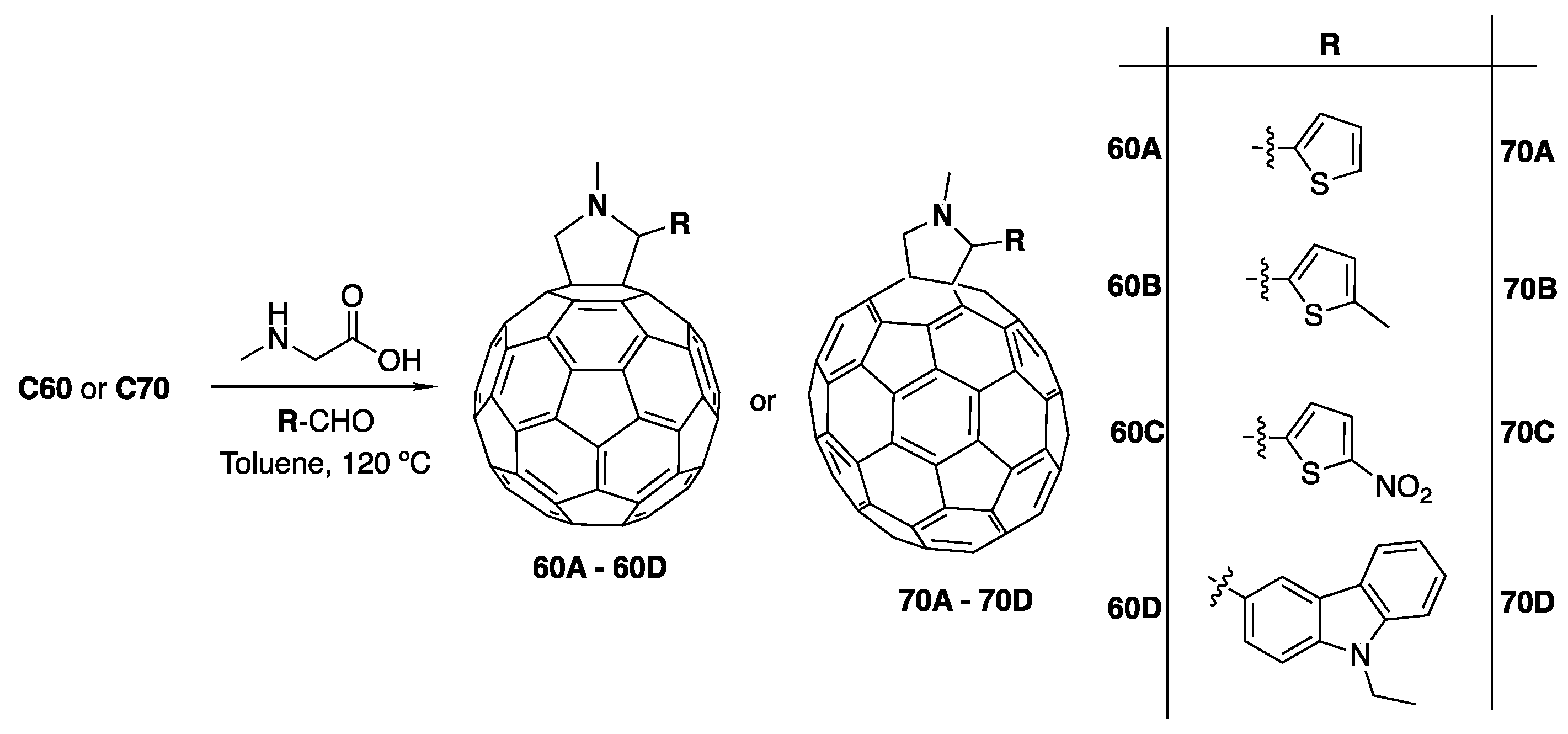
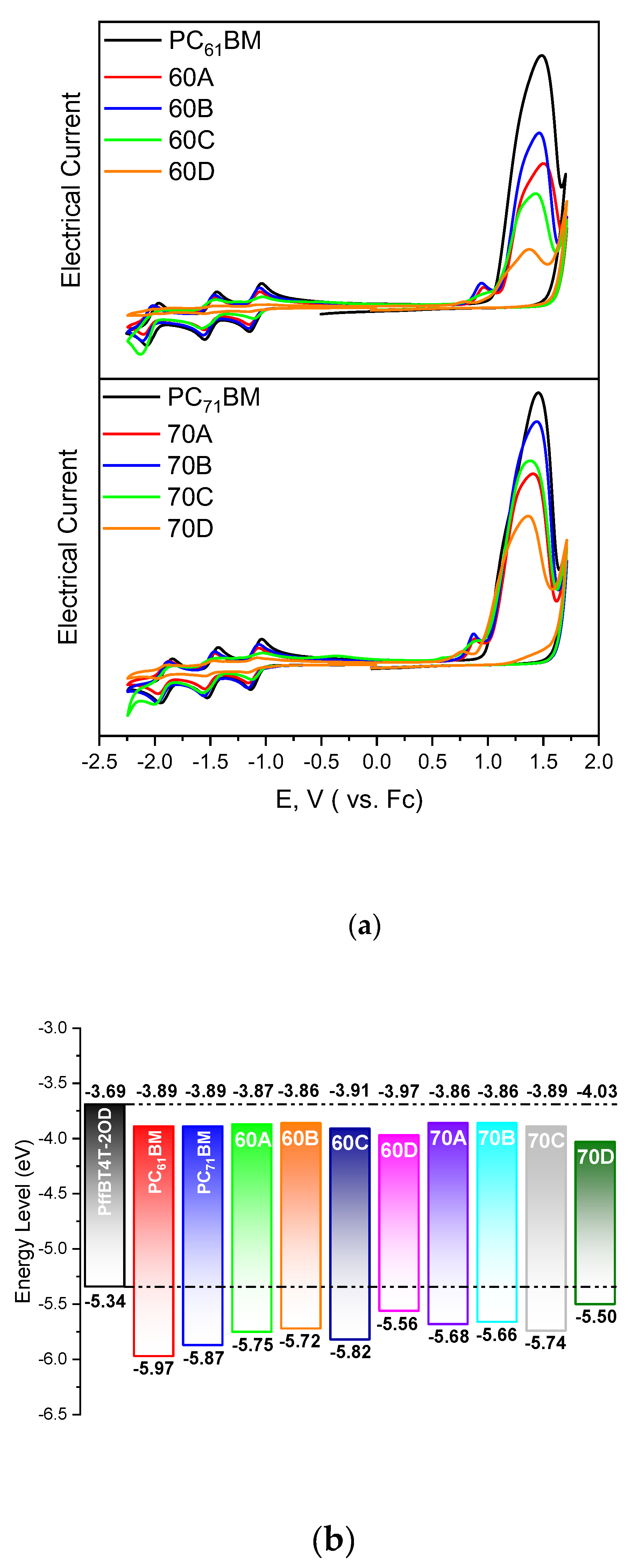
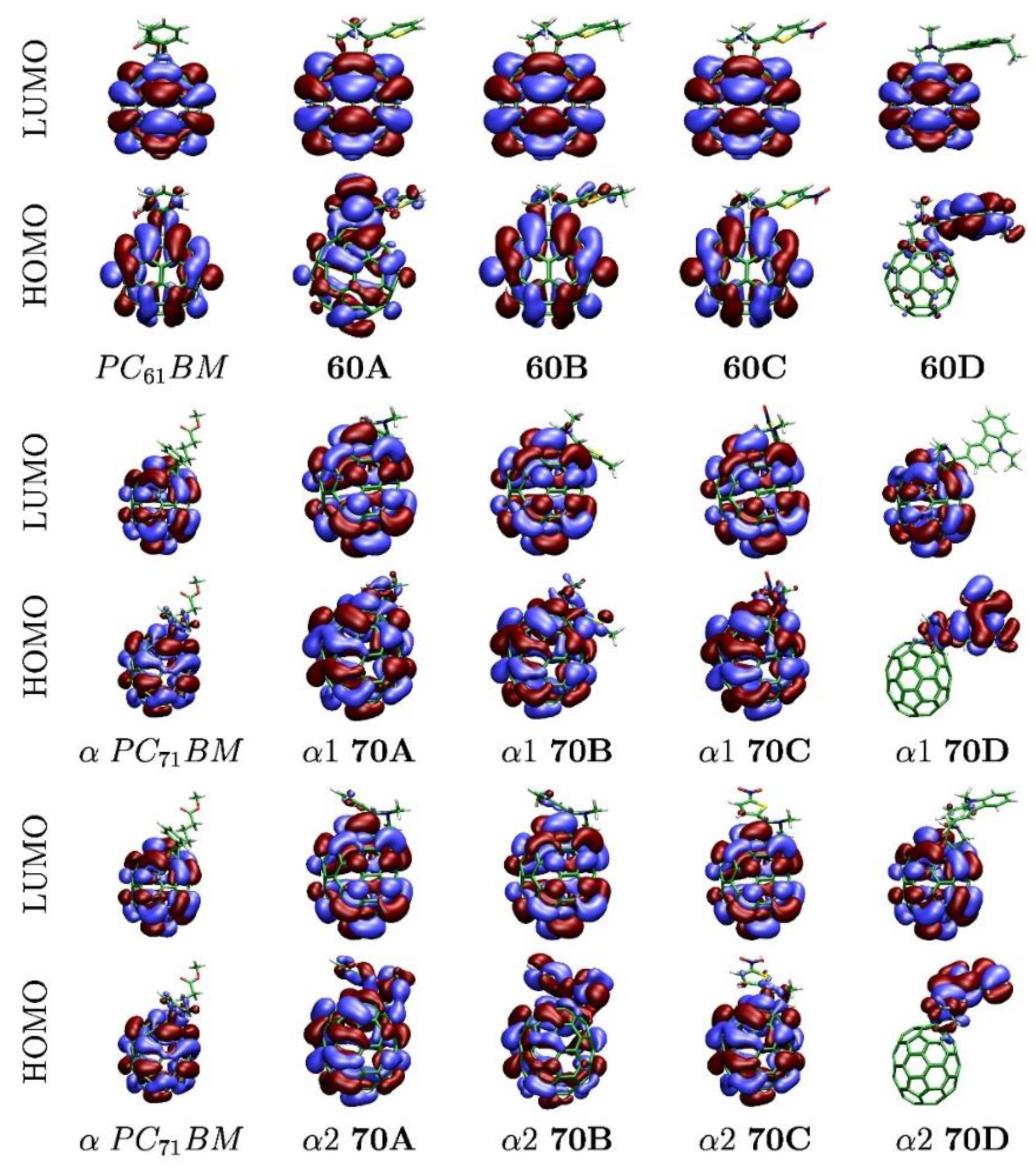
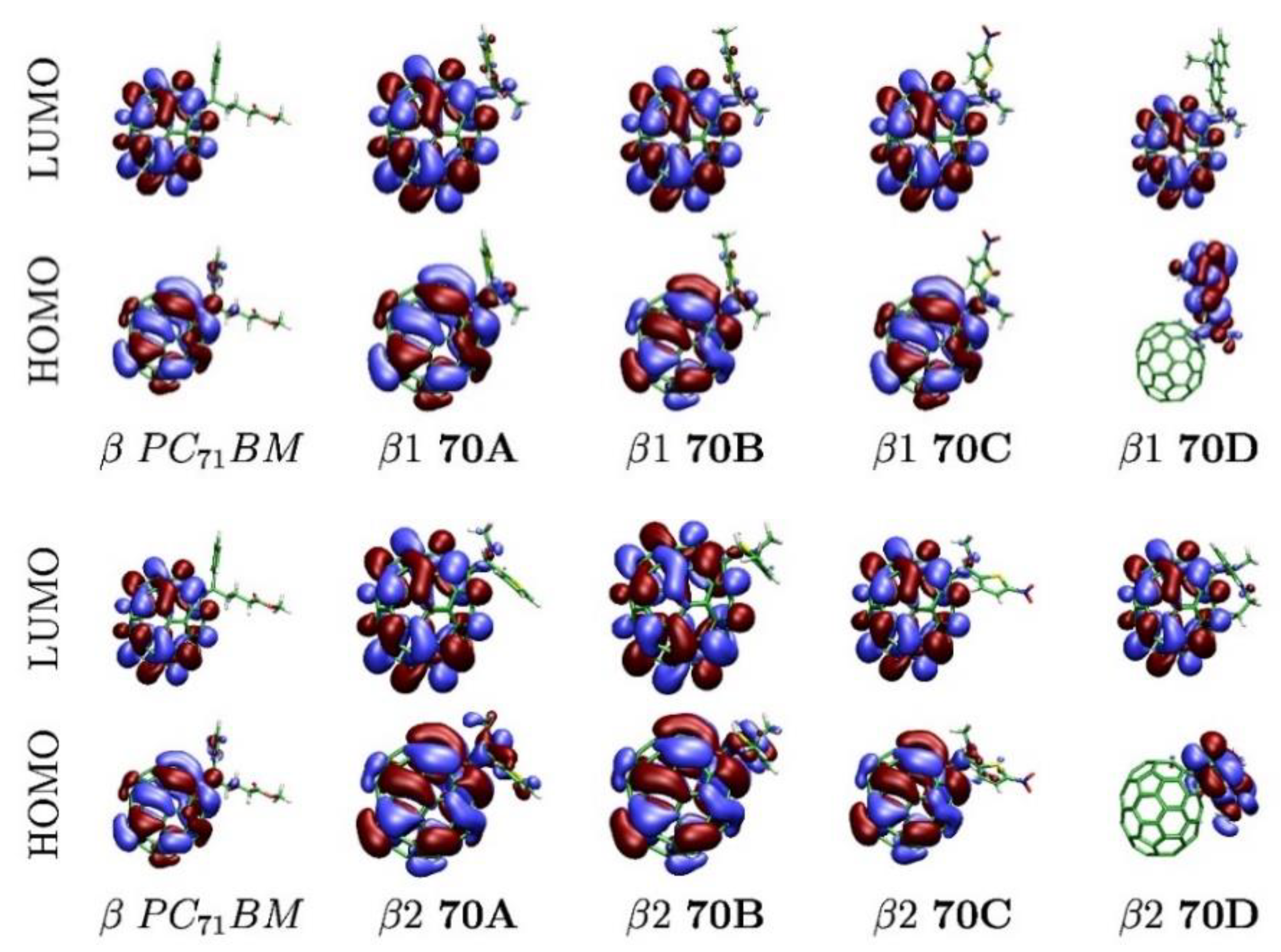
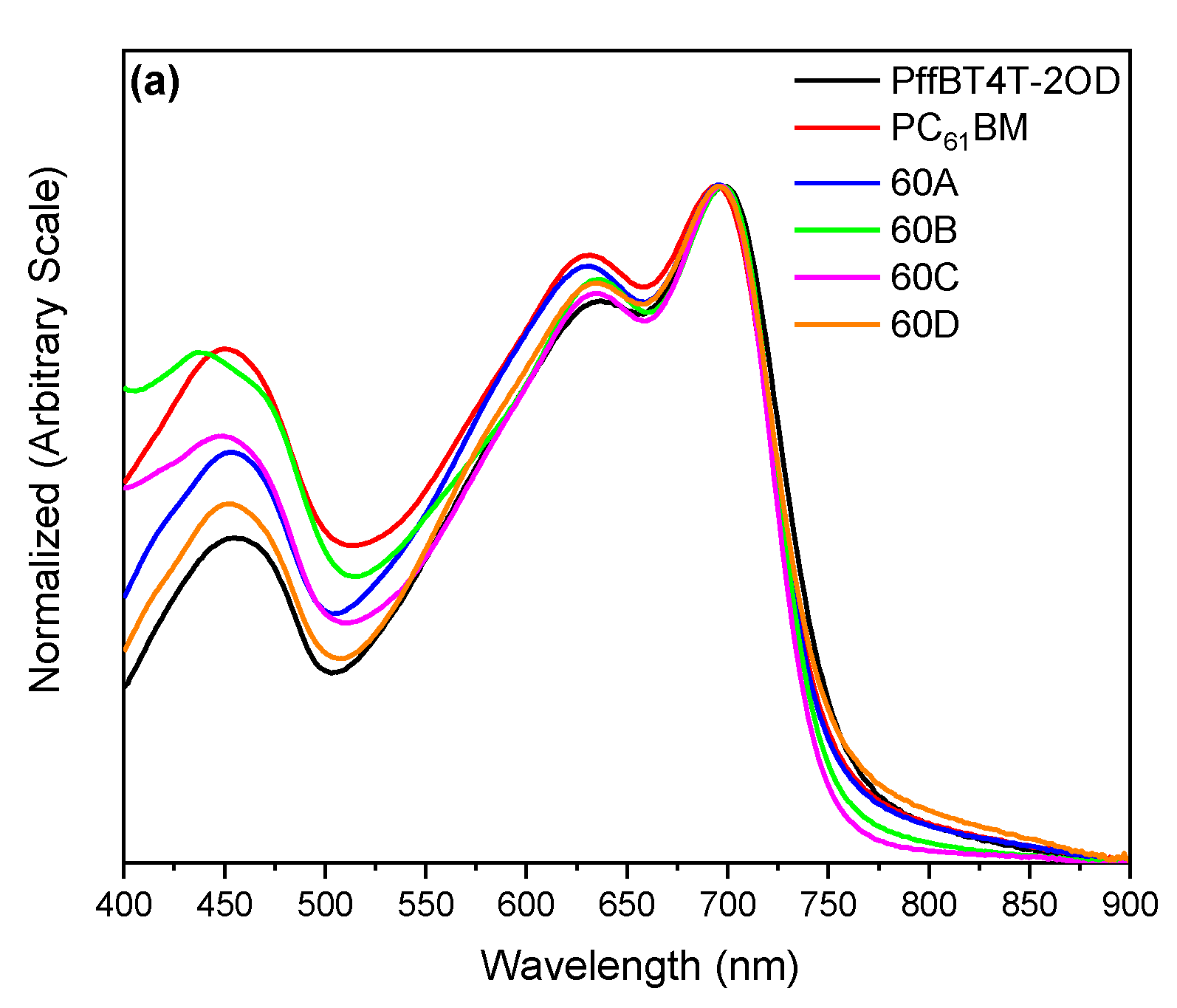
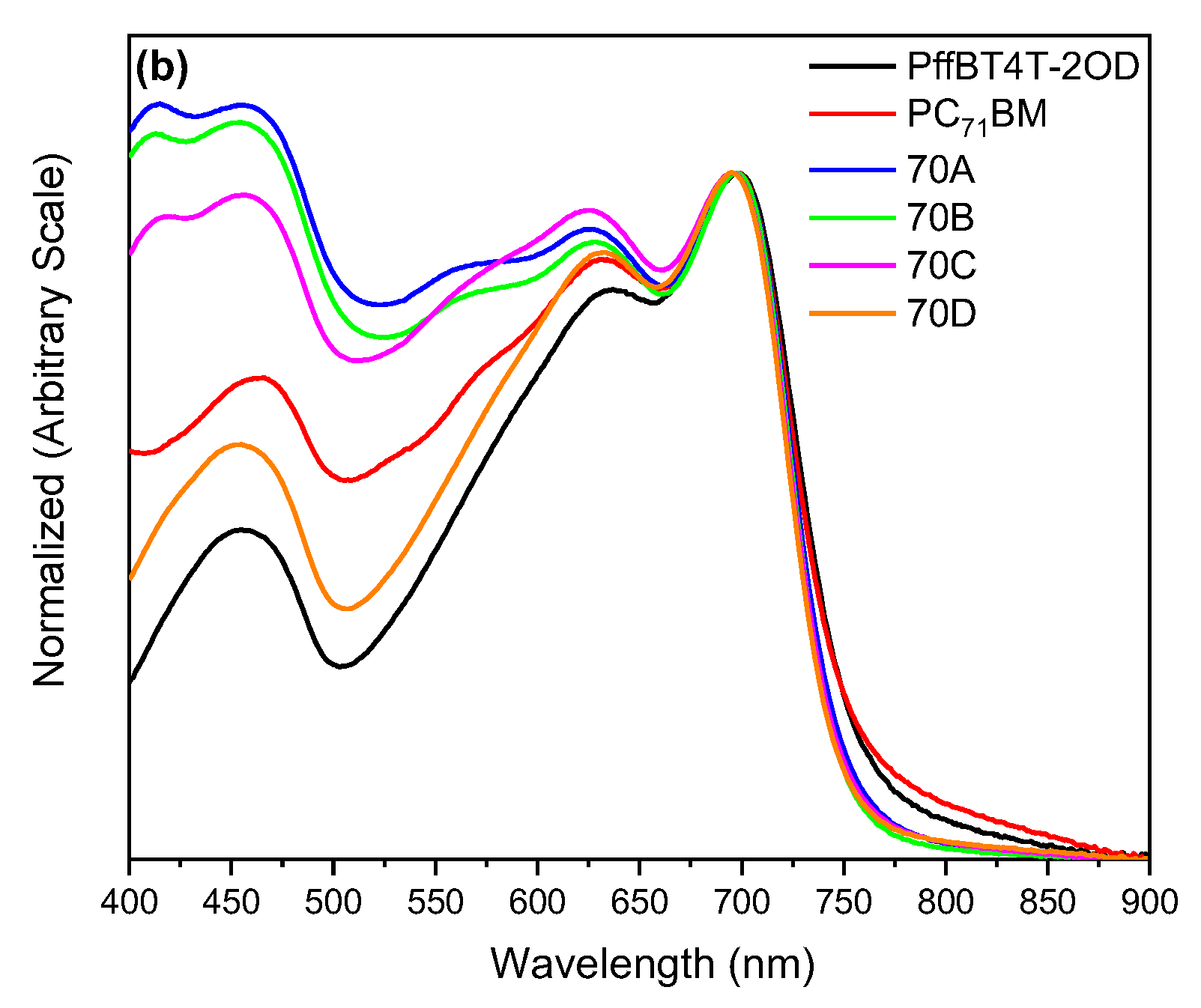
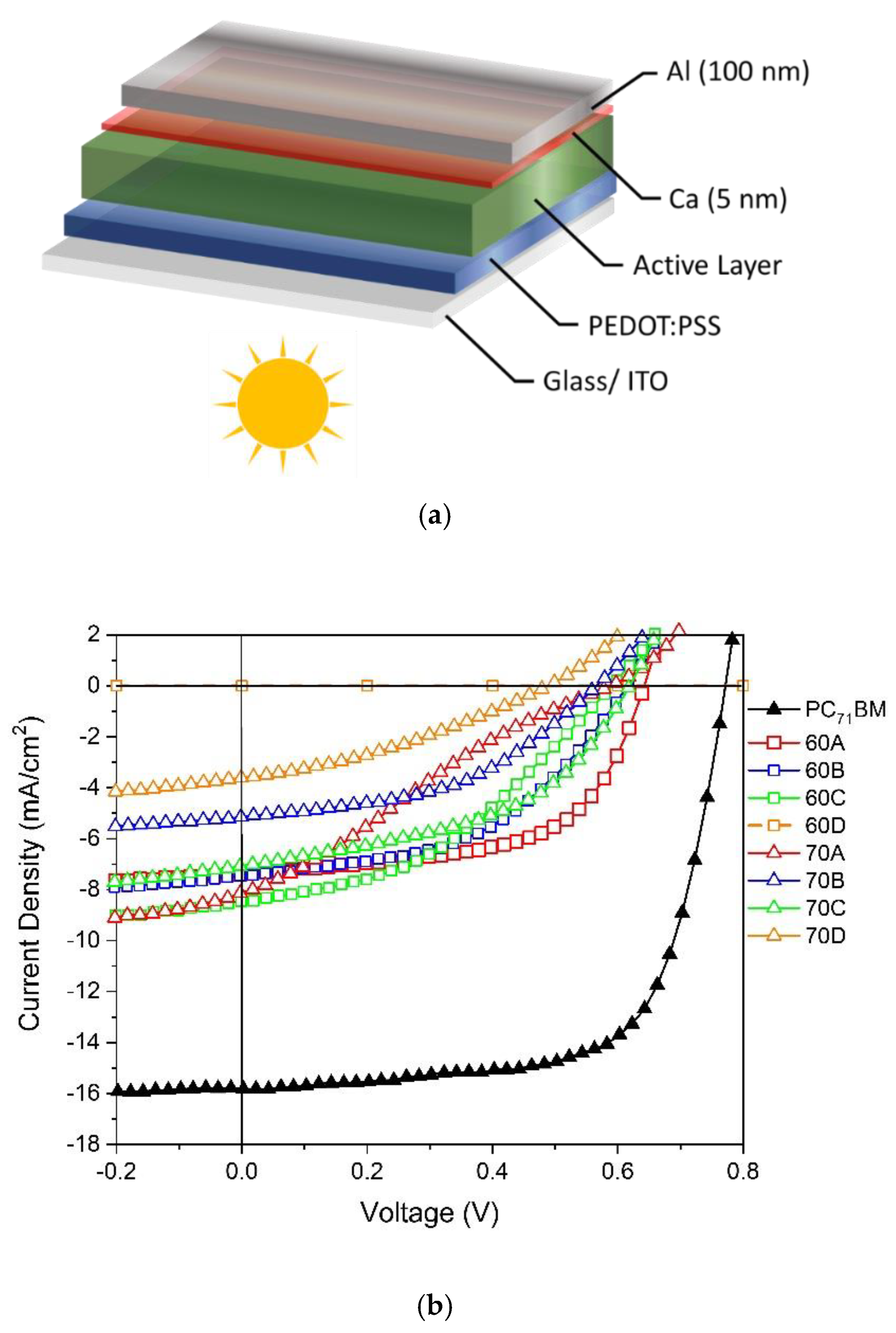

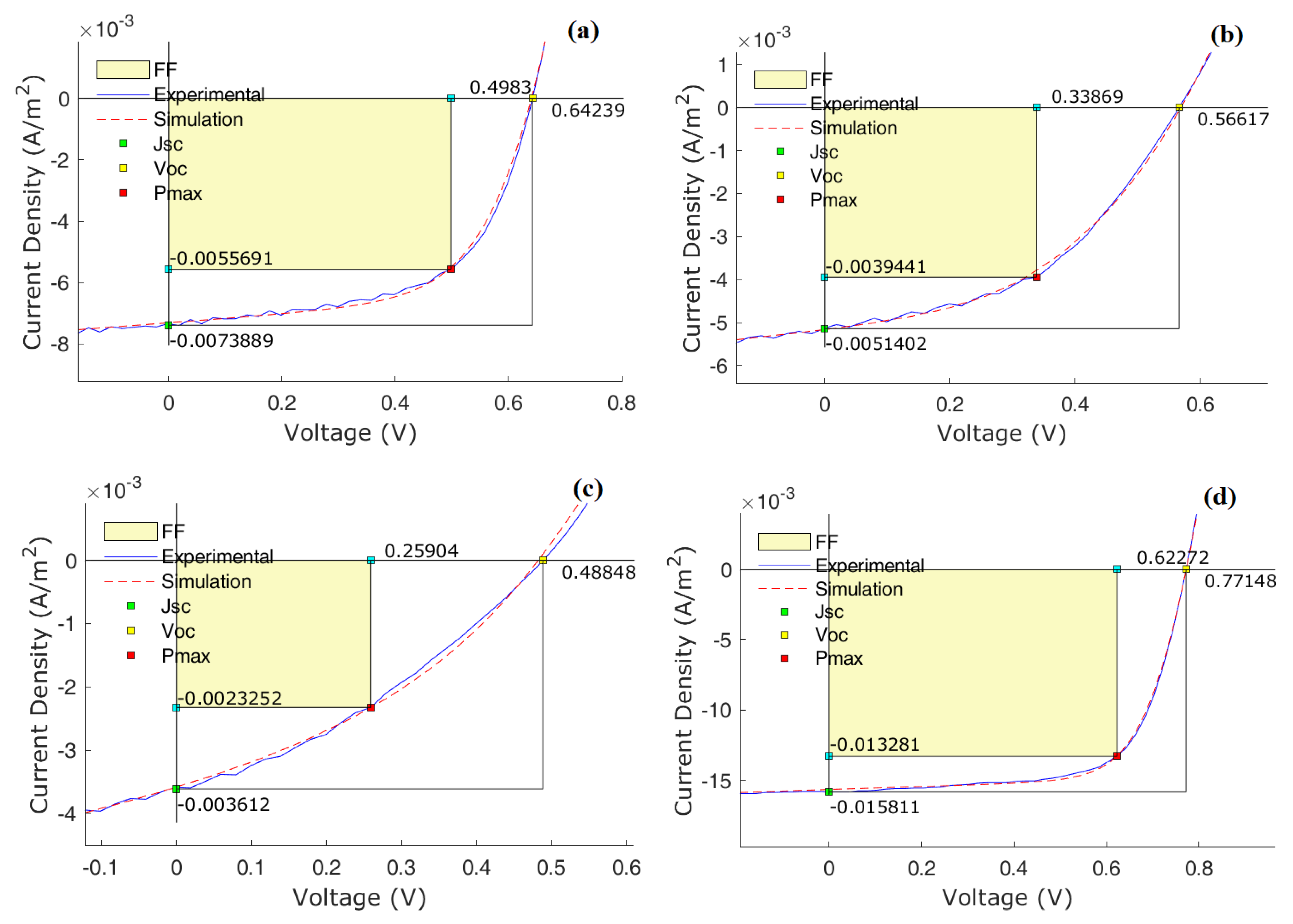


| α1 (%) | α2 (%) | β1(%) | β2 (%) | |
|---|---|---|---|---|
| 70A | 30 | 20 | 25 | 24 |
| 70B | 30 | 27 | 25 | 17 |
| 70C | 47 | 18 | 20 | 18 |
| 70D | * | * | * | * |
| HOMO | LUMO | |||||||||
|---|---|---|---|---|---|---|---|---|---|---|
| Exp. | α1 | α2 | β1 | β2 | Exp. | α1 | α2 | β1 | β2 | |
| C60 | −5.80 | −4.10 | ||||||||
| C70 | −5.80 | −4.03 | ||||||||
| PC61BM | −5.97 | −5.47 | −3.89 | −3.94 | ||||||
| PC71BM | −5.87 | −5.52 | −5.44 | −3.89 | −3.85 | −3.87 | ||||
| 60A | −5.75 | −5.40 | -3.87 | −3.90 | ||||||
| 60B | −5.72 | −5.36 | −3.86 | −3.88 | ||||||
| 60C | −5.82 | −5.60 | −3.91 | −4.06 | ||||||
| 60D | −5.56 | −5.09 | −3.97 | −3.84 | ||||||
| 70A | −5.68 | −5.47 | −5.47 | −5.40 | −5.38 | −3.86 | −3.79 | −3.79 | −3.84 | −3.83 |
| 70B | −5.66 | −5.43 | −5.42 | −5.37 | −5.35 | −3.86 | −3.77 | −3.77 | −3.82 | −3.83 |
| 70C | −5.74 | −5.69 | −5.69 | −5.61 | −5.60 | −3.89 | −4.01 | −4.00 | -4.06 | −4.04 |
| 70D | −5.50 | −5.06 | −5.05 | −5.04 | −5.12 | −4.03 | −3.76 | −3.75 | −3.80 | −3.79 |
| PffBT4T-2OD | PCE (%) | VOC (V) | FF (%) | Jsc (mA/cm2) |
|---|---|---|---|---|
| PC71BM | 8.41 (8.19 ± 0.24) | 0.72 (0.74 ± 0.02) | 71.2 (69.8 ± 1.8) | 16.41 (15.87 ± 0.40) |
| 60A | 2.78 (2.61 ± 0.16) | 0.64 (0.63 ± 0.01) | 58.7 (55.3 ± 3.9) | 7.36 (7.48 ± 0.15) |
| 60B | 2.20 (2.02 ± 0.20) | 0.62 (0.55 ± 0.09) | 47.9 (49.2 ± 2.9) | 7.46 (7.51 ± 0.98) |
| 60C | 2.04 (1.94 ± 0.12) | 0.59 (0.60 ± 0.01) | 40.7 (44.8 ± 3.0) | 8.46 (7.30 ± 0.90) |
| 60D | (0.07) | (1.09) | (45.6) | (0.15) |
| 70A | 1.15 (0.92 ± 0.15) | 0.59 (0.56 ± 0.03) | 24.2 (26.4 ± 2.5) | 8.08 (6.32 ± 1.30) |
| 70B | 1.33 (1.18 ± 0.16) | 0.57 (0.54 ± 0.03) | 45.9 (38.4 ± 4.4) | 5.14 (5.74 ± 0.68) |
| 70C | 0.75 (0.65 ± 0.08) | 0.62 (0.63 ± 0.01) | 47.5 (42.6 ± 4.0) | 2.52 (2.43 ± 0.16) |
| 70D | 0.60 (0.59 ± 0.02) | 0.49 (0.50 ± 0.01) | 34.2 (34.4 ± 1.6) | 3.61 (3.46 ± 0.34) |
| Jph (mA/cm2) | Rs (Ω) | Rp (Ω) | |
|---|---|---|---|
| PC71BM | 16.41 | 159 | 9.72 × 104 |
| 60A | 7.36 | 225 | 3.43 × 104 |
| 60B | 7.65 | 633 | 2.40 × 104 |
| 60C | 8.86 | 1157 | 1.39 × 104 |
| 60D | (0.15) | (6032) | (9.72 × 104) |
| 70A | 8.57 | 1721 | 0.57 × 104 |
| 70B | 5.33 | 1235 | 2.14 × 104 |
| 70C | 2.53 | 619 | 2.99 × 104 |
| 70D | 3.80 | 1644 | 1.41 × 104 |
© 2020 by the authors. Licensee MDPI, Basel, Switzerland. This article is an open access article distributed under the terms and conditions of the Creative Commons Attribution (CC BY) license (http://creativecommons.org/licenses/by/4.0/).
Share and Cite
Gaspar, H.; Figueira, F.; Strutyński, K.; Melle-Franco, M.; Ivanou, D.; Tomé, J.P.C.; Pereira, C.M.; Pereira, L.; Mendes, A.; Viana, J.C.; et al. Thiophene- and Carbazole-Substituted N-Methyl-Fulleropyrrolidine Acceptors in PffBT4T-2OD Based Solar Cells. Materials 2020, 13, 1267. https://doi.org/10.3390/ma13061267
Gaspar H, Figueira F, Strutyński K, Melle-Franco M, Ivanou D, Tomé JPC, Pereira CM, Pereira L, Mendes A, Viana JC, et al. Thiophene- and Carbazole-Substituted N-Methyl-Fulleropyrrolidine Acceptors in PffBT4T-2OD Based Solar Cells. Materials. 2020; 13(6):1267. https://doi.org/10.3390/ma13061267
Chicago/Turabian StyleGaspar, Hugo, Flávio Figueira, Karol Strutyński, Manuel Melle-Franco, Dzmitry Ivanou, João P. C. Tomé, Carlos M. Pereira, Luiz Pereira, Adélio Mendes, Júlio C. Viana, and et al. 2020. "Thiophene- and Carbazole-Substituted N-Methyl-Fulleropyrrolidine Acceptors in PffBT4T-2OD Based Solar Cells" Materials 13, no. 6: 1267. https://doi.org/10.3390/ma13061267
APA StyleGaspar, H., Figueira, F., Strutyński, K., Melle-Franco, M., Ivanou, D., Tomé, J. P. C., Pereira, C. M., Pereira, L., Mendes, A., Viana, J. C., & Bernardo, G. (2020). Thiophene- and Carbazole-Substituted N-Methyl-Fulleropyrrolidine Acceptors in PffBT4T-2OD Based Solar Cells. Materials, 13(6), 1267. https://doi.org/10.3390/ma13061267










